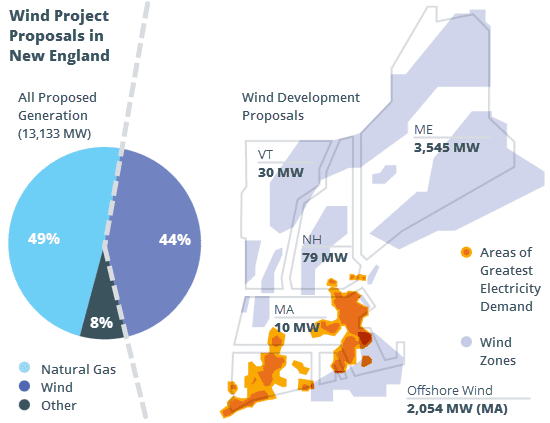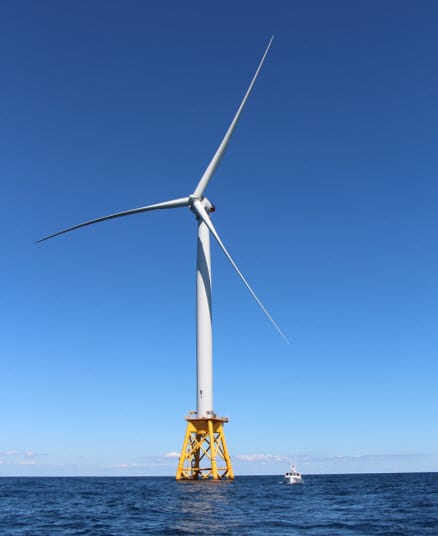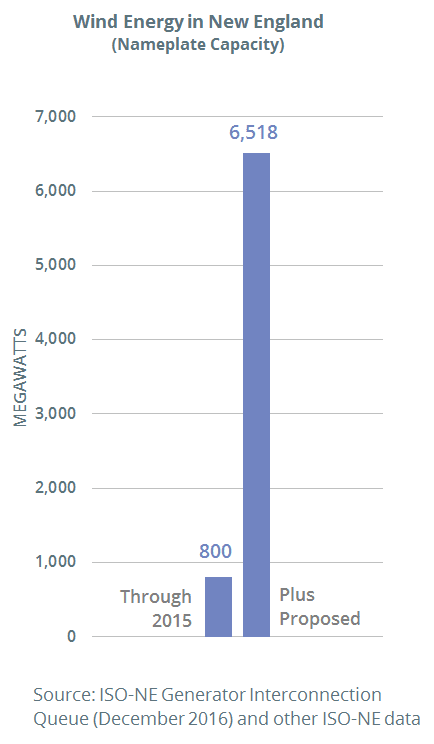Turbines are spinning at the nation’s first offshore wind facility
 ISO-NE continues efforts to help integrate more offshore and onshore wind energy in New England
ISO-NE continues efforts to help integrate more offshore and onshore wind energy in New England
On December 12, 2016, Deepwater Wind announced that its Block Island Wind Farm had begun delivering electricity to the grid—a historic occasion for both the region and the US. The facility represents the first offshore wind farm in the nation and is paving the way for similar projects to harness New England’s significant offshore wind energy potential. As of December 1, three offshore wind projects representing 2,054 megawatts (MW) were requesting interconnection to the regional power system. Federal and state efforts are helping spur the growth of this new industry. Recent Massachusetts legislation, for example, allows the state to procure approximately 1,600 MW of offshore wind, and several offshore wind projects across the country are receiving grants from the US Department of Energy.


The wind farm, located 16 miles off the Rhode Island mainland near Block Island, comprises five wind turbines, each of which is capable of producing 6 MW of zero-emission electricity. The facility’s 30 MW of total capability will be more than enough to replace the diesel generators that previously powered the island; about 90% of the facility’s output will be exported back to the mainland via a new underwater transmission cable to help meet regional electricity demand.
 In February’s Forward Capacity Auction, the wind farm won supply obligations committing it to provide electricity when called on by the ISO during the June 2019 through May 2020 period. The auction is an annual process to procure the resources that will be needed to meet projected future regional demand. A total of 27 MW of energy was procured from wind resources—read the auction press release.
In February’s Forward Capacity Auction, the wind farm won supply obligations committing it to provide electricity when called on by the ISO during the June 2019 through May 2020 period. The auction is an annual process to procure the resources that will be needed to meet projected future regional demand. A total of 27 MW of energy was procured from wind resources—read the auction press release.
The wind farm’s commercial operation caps an eight-year development effort. After the project’s initial proposal in 2008, a lengthy period followed to secure permits and financing. Construction began mid-2015 and was completed this fall, after which a testing phase began. Learn more about the project in a presentation by Jeffrey Grybowski, Deepwater Wind CEO, to the region’s Consumer Liaison Group in September.
Facilitating the integration of wind energy in New England
The region could reach more than 6,500 MW of wind energy by 2023 if all the onshore and offshore wind projects currently proposed in the ISO Generator Interconnection Queue are developed. However, one obstacle to connecting more onshore wind energy is the need for new or improved transmission lines and facilities because these projects are typically located in more remote areas where the transmission system was originally built to handle a much smaller demand for electricity. For an animated visualization of the projected growth of wind energy across the country through 2050, see the Department of Energy’s Wind Vision map.
 Many recent and ongoing ISO projects are helping to accommodate adding more onshore and offshore wind energy in New England. For example:
Many recent and ongoing ISO projects are helping to accommodate adding more onshore and offshore wind energy in New England. For example:
- In 2016, we engineered a revolutionary method of accounting for the variable “fuels” powering wind resources and certain hydro resources, which can now be efficiently dispatched and set real-time prices. Read “ISO-NE incorporates wind-powered resources into real-time dispatch with Do Not Exceed Dispatch Project.”
- We’ve found ways to speed up our engineering studies of proposed wind power projects.
- We’ve also streamlined the process for Elective Transmission Upgrades (ETUs)—transmission lines funded by private parties—which may help support state efforts to integrate more wind and renewable energy. Read “FERC accepts rule changes for regional Elective Transmission Upgrades.”
- In September, the ISO also released results of an economic study requested by regional stakeholders to evaluate the economic impacts of hypothetically adding several thousand megawatts from offshore wind facilities. The study suggests the region could see sizable economic and environmental benefits. Read “Results of three stakeholder-requested economic studies on wind development.”
Read more about the challenges the ISO faces in integrating more wind and other renewable power resources.
- Categories
- Inside ISO New England
- Tags
- renewable resources, wind
